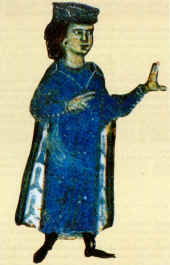Cantiga de amor (Portuguese and Galician) or cantiga d'amor (Galician-Portuguese), literally "love song", is a type of literary composition from the Middle Ages, typical of the medieval Galician-Portuguese lyric.[1][2]

A male-voiced love lyric, they on average have more complex forms, many never found in cantigas de amigo and some highly complex ones that were directly inspired by Occitan and Old French lyrics.[a] On the other hand, cantigas de amor have a lack of variation in personae – with the man almost always speaking to or about a woman – and of situations. Usually the man is courting the woman, complaining that she is being cruel to him, despite his love and loyalty, though sometimes he is leaving or coming back, is away from her, and, seldom, the man gets so frustrated, angry or jealous that he gives up on her and even insults the woman. Obscenity and open sexual references are taboo on this lyric.[3]
Cantigas de amor have a more complex rhetoric, and there is far more variation in the relationship between metrical and syntactic units, with a much higher frequency of enjambement.[4]
Scholars generally assume that the cantiga de amor comes from France. Scholars such as Henry R. Lang[b] have pointed to clear thematic parallels between the cantiga de amor and Occitan and Old French lyrics. Cesare De Lollis[c] pointed two erotic genres in Galician-Portuguese before the first written texts, and concluding that the cantiga de amor was written before the first extant cantiga de amigo, and that some elements of the cantiga de amor came before the Occitan and Old French influences. It is difficult to fully trace back the origins of the genre since it was highly influenced by foreign lyric compositions.[5]
- ^ "Sobre as cantigas". Cantigas Medievais Galego-Portuguesas (in Portuguese). Retrieved 24 February 2019.
- ^ Cohen, Rip; Parkinson, Stephen (2013). "2: The Medieval Galician-Portuguese Lyric". In Parkinson, Stephen; Alonso, Cláudia Pazos; Earle, T. F. (eds.). A Companion to Portuguese Literature (reprint ed.). Boydell & Brewer. p. 25. ISBN 9781855662674.
- ^ Cohen, Rip; Parkinson, Stephen (2013). "2: The Medieval Galician-Portuguese Lyric". In Parkinson, Stephen; Alonso, Cláudia Pazos; Earle, T. F. (eds.). A Companion to Portuguese Literature (reprint ed.). Boydell & Brewer. pp. 27–28. ISBN 9781855662674.
- ^ Cohen, Rip; Parkinson, Stephen (2013). "2: The Medieval Galician-Portuguese Lyric". In Parkinson, Stephen; Alonso, Cláudia Pazos; Earle, T. F. (eds.). A Companion to Portuguese Literature (reprint ed.). Boydell & Brewer. p. 28. ISBN 9781855662674.
- ^ Cohen, Rip; Parkinson, Stephen (2013). "2: The Medieval Galician-Portuguese Lyric". In Parkinson, Stephen; Alonso, Cláudia Pazos; Earle, T. F. (eds.). A Companion to Portuguese Literature (reprint ed.). Boydell & Brewer. p. 39. ISBN 9781855662674.
Cite error: There are <ref group=lower-alpha> tags or {{efn}} templates on this page, but the references will not show without a {{reflist|group=lower-alpha}} template or {{notelist}} template (see the help page).